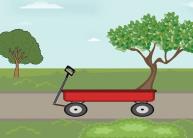
Mary, an independent, strong-willed woman all of her life, realized that she might need help managing her finances. She came to me with concerns that her memory might be slipping a little, and she was afraid that she might forget to pay her bills. After assuring her that she was fine, I encouraged her to consider placing her assets in a trust so that she could write her own rules for management of those assets. Mary was skeptical. “Trusts are way too complicated for me! I don’t even know what a trust is. And who would be the trustee?”
I explained that a trust is very much like that little red wagon you had when you were a kid. I have a picture of my sister hauling me around in a red Radio Flyer wagon when I was about three years old, and I remember using that wagon to cart my Barbie dolls to the neighbor’s house. I also remember that I was the boss of that wagon, and would only let my best friend, Paula, touch that wagon and the Barbies in it.
So, how is a trust like that wagon?
A wagon is a receptacle – a place to put your “stuff”. When you were a kid, you probably put all of your important toys, and things you found by the side of the road, inside that wagon. You took the handle of the wagon and pulled the “stuff” wherever you wanted it to go. You could take things out of the wagon, or put new things in the wagon, whenever you wanted. When you got tired, you put down the handle. If you wanted, you could allow someone else to take the handle and haul your stuff for you. You made the rules for your wagon.
A trust is like that. You put your assets – your adult “stuff” – in the trust. While you are alive and well, you can be the trustee. The trustee is the person that puts the stuff in the trust, makes sure the stuff in the trust is taken good care of, and takes the stuff out of the trust whenever necessary. When you no longer want to be the trustee, or you can no longer serve as trustee because of incapacity or death, someone else will pick up the handle and serve as the trustee.
As the trust maker, you get to decide the rules of the trust. Just like you could decide who got to pull your wagon, you get to decide who will be the trustee. You can also decide who will benefit from the things in that trust and when they can benefit.
Unlike the rules you made up as a child, though, the rules of the trust are written in a document so that the person serving as trustee knows the rules and must legally follow those rules.